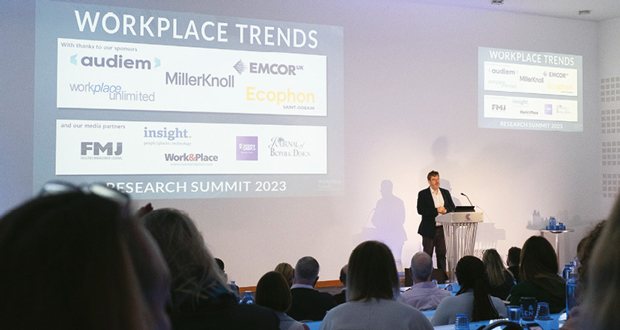The overriding theme of the Workplace Trends Research Summit was the challenge of creating workspaces where people can both collaborate and concentrate, work together but have the choice of being apart
Introducing the Workplace Trends Research Summit which took place in April at the Cavendish Conference Centre, London and online, Nigel Oseland, co-curator and morning moderator reminded delegates that all the content is peer reviewed and it showed in the quality and depth of the presentations.
We’re all grappling with hybrid working said Bertie van Wyk of MillerKnoll Insight Group. His trends update revealed that 81 per cent of employees want flexibility on where they work and a staggering 93 per cent when they work. But people also need structure, and the research found employees who don’t believe their company is being very transparent about their post-pandemic remote working policies are 2.3 times more likely to look for a new position.
“Do we care whether we go into the office or not to do our jobs?” asked Lorna Landells and Darren Yates of Remit Consulting in their survey into how the pandemic had impacted office occupancy levels. The answer according to the research is yes. While productivity spiked at the beginning of lockdown there has been a steady downward trend as feelings of isolation and lack of collaboration has increased.
What happens when offices are no longer an active asset to support employee connection, networks and relationships? Rachel Casanova and Sophie Schuller of Cushman & Wakefield consideration of these human factors found that high performance buildings don’t compensate for mediocre management. When expectations for a workplace are set at a higher threshold, they warned, the organisational culture needs to match up.
WORKPLACE BEHAVIOURS
Taking a deeper dive into the behaviours of office workers, Dr Brett Pollard of Hassell study of associations between movement and office layout provided some illuminating insights into office habits. This included the more work-points people could see, the less they moved; while placing amenities further away to encourage movement resulted in ‘work arounds,’ such as stockpiling rubbish, utilising print storage functions and even drinking less water.
In his research on two institutions offering activity-based working, Dan Wakelin of HCG discovered that with less populated offices, some occupants ‘claimed’ space ownership by simply showing up more regularly. An organisation which speaks of flexibility but manages by presence will struggle to introduce activity-based working, he said. “My challenge to you is to make sure your workplace is doing and saying the things you want it to say.”
Dr Harriet Shortt from the University of the West of England & Bibo Studios took us on a visual tour of the Bristol Business School building with the use of participant-led photography to illustrate how students and teaching staff were utilising a very transparent and open plan building. It emerged that many users had a sense of surveillance in the space, and that striving to put the ‘brand on show’ led occupants to create their own private den’s.
Buildings may encourage collaboration and being together but we also need privacy and space for ‘deep work’ explained Shortt. People may choose to go to the building to be near other people but also want their own space. She advised: “We need to develop a language for this evolving need to be ‘with and without’ or rather ‘alone together’. We’re ‘alone not lonely’, want to feel connected but act disconnected and the creation of a den captures that need to alone together.”
WELLBEING AT WORK
Lene Becker of LAIKA Rumdesign echoed this sentiment in her look at mental wellbeing at work, where she said good design instils occupants with a feeling of connectedness but gives them the choice to opt for quieter areas. Reflecting this approach, Paige Hodsman of Brunel University and Saint-Gobain Ecophon put forward a strong argument for considering both acoustic perceptions and personality traits when assessing the causes and implications of burnout.
It’s important that workplaces are designed for inclusivity for all types of brains said David O’Coimim of Nook. He postured the idea of the open plan workplace being like a stage which can be a challenge for the neurodiverse in particular. Reflecting the creation of dens in the Bristol case study, he suggested ‘hackability’ in furniture and fitting design which offers occupants the flexibility to create their own personalised spaces.
Rounding off the day, Kasia Maynard of the Gensler Research Institute presented more evidence of people’s needs to be together and apart; as it’s research shows the two main reasons people are going back to the office is to work in person with colleagues and focus on their work. Workplaces that have effective spaces and deliver a great experience will become destinations of choice she added, which includes ensuring amenities – from coffee shops and food outlets to fitness and wellbeing facilities are available whether in the local area or on-site.
With the establishment of hybrid work patterns there is no better time to rethink work and how it sits in a new ecosystem, concluded Maynard. It seems this new workplace is where you can still feel connected but have the option of working alone.





